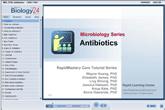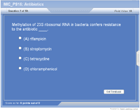| How to Learn in 24 Hours? |
|
| Need Help? |
M-F: 9am-5pm(PST):
Toll-Free: (877) RAPID-10
or 1-877-727-4310
24/7 Online Technical Support:
The Rapid Support Center
vip@rapidlearningcenter.com
Secure Online Order:

|
| Tell-A-Friend: |
Have friends taking science and math courses too? Tell them about our rapid learning system.
|
|
Antibiotics
| Topic Review on "Title": |
Introduction of Antibiotics their mechanisms of action and cellular targets.
- Antibiotics are antimicrobials that can kill or inhibit growth of susceptible organisms.
- Antibiotics are targeted antimicrobials that usually affect a metabolic pathway.
- Beta lactam-A beta-lactam ring or penam: is a lactam consisting of a heteroatomic ring structure containing three carbons and one nitrogen atom.
- Beta Lactams Antibiotics bind and inhibit enzymes involved in cell wall synthesis. Little effect on non replicating bacteria. Lethal to dividing bacteria.
- Penicillin: is an antibiotic used to treat bacterial infections (usually Gram-positive). Originally derived from the blue-green mold Penicillium.
- Penicillin binds irreversibly to transpeptidase and prevents it from cross linking the peptidoglycan units of the cells wall.
- Cephalosporin: beta-lactam family of antibiotics, bactericidal, prevents cell wall synthesis.
- Tetracycline: interfere with protein synthesis by binding to ribosomes.
- Glycopeptides are molecules that work by interfering with the synthesis of bacterial cell walls.
- Polymyxin: antibiotic damages the cytoplasmic membrane of bacteria. Polymyxin is produced by the bacteria Bacillus polymyxa. Increase the permeability of bacterial cell membranes causing a loss of equilibrium.
- Aminoglycosides: is a collections of antibiotics that target the cells ribosome and cause error prone reading of the mRNA inhibiting protein synthesis. Aminoglycosides include: amikacin, gentamicin, kanamycin, neomycin, netilmicin, paromomycin, streptomycin, tobramycin and apramycin.
- Rifampin is derived from rifamycin and interferes with RNA synthesis by binding to RNA polymerase.
- Antifungal drugs inhibit the growth of fungi. Typically toxic to humans because both organisms are eukaryotic. Examples include: imidazole, clotrimazole, ketoconazole, miconazole and others. They extract membrane sterols or prevent their synthesis.
- Antibiotics can be synthetically produced. Alternatively organisms producing antibiotics can be grown in fermentation flasks and the products separated.
- Antibiotic resistance to beta lactams is a result of an enzyme called beta lactamase which break the beta lactam ring. The gene for the enzyme can be transferred between bacteria resulting in resistance.
Antibiotic Targets
- Cell Wall which provides the bacteria a outer protection and mediates the amount of liquid that can enter and leave the cell.
- Cell Membrane: is a lipid bilayer and functions as a permeability barrier.
- Cellular Proteins: these targets can include ribosomes and other proteins vital for cell metabolism and reproduction.
- Cellular Nucleic Acids: interfere with DNA production.
- Many antibiotics, fungicides, antimalarials and antivirals act on the DNA or RNA of a cell.
- Gene function may be suppressed by inhibiting nucleic acid or protein biosynthesis.
- Enzyme Inhibition: irreversible or reversible binding or competitive inhibition of cell enzymes.
Antimetabolites
- Chemotherapy exploits the biochemical differences between host and pathogen.
- Metabolites are substances used or produced by biochemical reactions.
- Antimetabolite is a drug or chemical that has chemical similarity (is a mimic) to a natural metabolite.
- Sulfa Drugs and it analogs were the first ant metabolite successfully used against microbes.
- Folic Acid analogs block the final conversion of PABA to folic acid which results in nucleotide and protein synthesis inhibition in bacteria.
- Gram-Positive bacteria have multiply layers of peptidoglycan stacked to form the cell wall. The peptidoglycan portion of the cell wall consists of repeating units of N-acetylglucosamine linked b-1,4 to N-acetylmuramic acid (NAG-NAM).
|
| Rapid Study Kit for "Title": |
| Flash Movie |
Flash Game |
Flash Card |
| Core Concept Tutorial |
Problem Solving Drill |
Review Cheat Sheet |
 |
 |
 |
|
| "Title" Tutorial Summary : |
Antibiotics have two primary mechanisms by which they act. They can either stop a bacterium from growing which is referred to as bacteriostatic or they can kill the bacterium which is called bactericidal. In either case to work the antibiotic must be brought into contact with the bacteria.
This module present several of the most important antibiotics used in medicine and their modes of action. The primary target of the antibiotic such as cell wall synthesis, DNA replication and metabolic protein inhibition is discussed.
|
| Tutorial Features: |
Specific Tutorial Features:
- Medically relevant antibiotics, their mechanism and targets a discussed.
- Antibiotic resistance is introduced.
- Enzyme inhibition as a mechanism for controlling microbial growth is outlined.
- Antibiotic production and purification methods are presented.
Series Features:
- Focus questions to emphasize key learning objectives in the module are posed.
- Definition slides introduce terms as they are needed.
- Examples given throughout to illustrate how the concepts apply.
- A concise summary is given at the conclusion of the tutorial.
|
| "Title" Topic List: |
Develop an understanding for how antibiotics work.
Form a working knowledge of antibiotics have selective toxicity.
Learn how microorganisms develop resistance to antibiotics.
Be able to list the major antibiotics used in medicine.
Bacteria structure and function as it relates to antibiotics.
|
See all 24 lessons in Anatomy and Physiology, including concept tutorials, problem drills and cheat sheets:
Teach Yourself Microbiology Visually in 24 Hours
|



